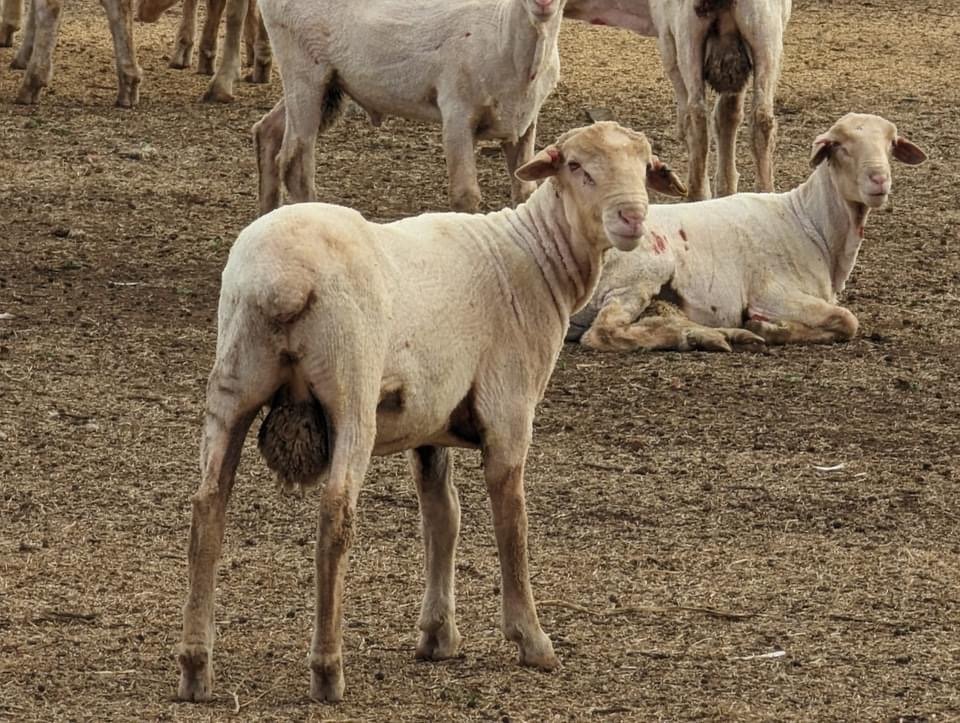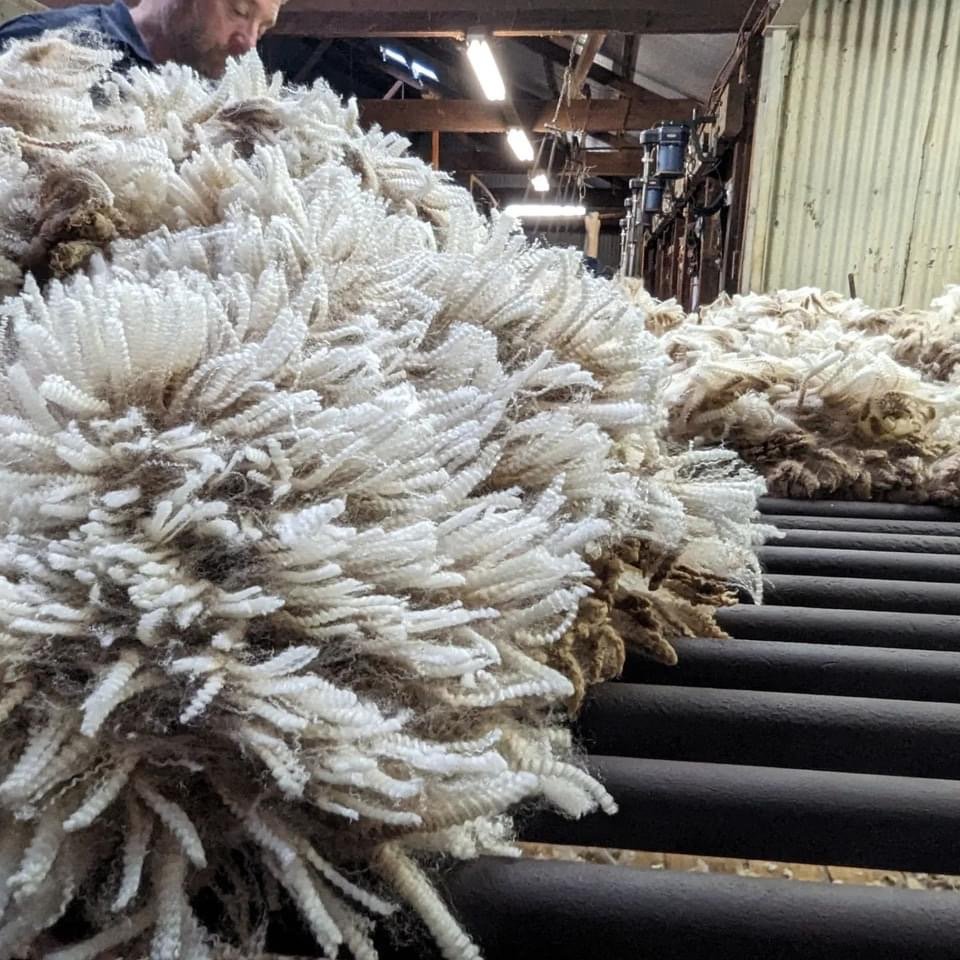Welcome to the first edition of the Baderloo monthly newsletter. Each month, we will update you with what's happening at Baderloo and across the industry to help you better manage your flock and achieve your goals. We hope you find it useful, and feel free to share it!
Monthly Wrap Up
The month of April is always a busy time at Baderloo. We finalised all mob movement after joining back to Baderloo, Wrattonbully, Campbell Range and Wirrilla from summer lease and agistment land. This includes droving mobs up to 20kms and trucking other mobs that are too far for droving.
We completed pregnancy scanning on Monday, 17th April. Brendan Robberson made the long trip from Mangoplah NSW, to share his unique skills with us to scan for multiples and foetus aging.
Ram lambs were moved home at the end of March for shearing and are now grazing some barley paddocks after an early class up in preparation for classing in June.
An early break has seen us receive good rain from late March to April, prompting us to get busy sowing feed. While we are keen to get moving, it will be an excellent opportunity to get a good knockdown on some weeds before dry sowing commences in May.
Our shearing crew were in full swing from 19th April to 26th April. It was all hands on deck, including our two oldest sons, Charlton (11) and Oscar (10), getting in on the action to do their first paid gig as roustabouts.
Baderloo Breeding Program
Our lease and agistment comprise 4,250 acres of summer stubble grazing stretching over about 70km. We can spell our winter hills and pastures for the summer to maintain cover and a winter stocking rate on these pastures.
As these paddocks are harvested, we can start moving ewes to these fresh paddocks in their joining mobs, ready for mating. With the very late season, ewes were gradually moved from mid-December, with the last mobs going to their paddocks only days before joining in mid-January.
Our ewes are single sire joined for 35 days and then boxed up and back-up joined again in case of ram failure. At the end of the 35 days, a select few rams are joined to our ewe lambs. Ewe lambs are selected on weight over 48kgs, and a quick class on the structure and early genomic data is done to remove any ewes not considered good enough to join. They are then split into two sire lines and joined for 35 days.
One group were joined to Trigger Vale (190760). The ewes bought with them superior wool qualities and great data indicating a big gain in muscle, fat and fertility. The other group were joined to the two Leahcim rams, 202503 and 212607, purchased in 2021 and 2022 and a son of 202503, 220357. With the rams having no direct relations to the ewe lambs, it made for straightforward joining decisions with exceptional data on the sires and the ewe lambs. We are super excited to see where this joining takes us.
Having early genomic data and muscle and fat scanning brought forward to the start of January, we selected five ram lambs for joining this year. There were some exceptional genetics on offer amongst these young rams, and we are very excited to capitalise on our genetic gain. The rams were selected for having superior wool quality, a balance of industry-leading ASBV traits and a very correct structure. Three of the chosen rams ranked 200 on the DP+ index due to an exceptional balance of high-value traits. The ram lambs were joined to 107 ewes with minimal dry ewes at pregnancy scanning.
Robberson Pregnancy Scanning
It was a pleasure to welcome Brendan Robberson from Robberson Pregnancy Scanning to test our stud ewes for the third consecutive year. Brendon's ability to scan for multiples and foetus age into week blocks is a game changer for our operation. It allows us to predict accurate birth dates for our Breeding Values and is a fantastic tool for our sheep management decisions.
While we knew there would be advantages for our management using foetus age, we did not realise just how useful it would be in differing seasonal conditions. Over the last three years, this data has become essential to our lambing and land management.
After breaking down foetus age groups, we can match group size to paddock size and run the ewes with higher feed demand on our better paddocks and look after those not as productive with our single bearing use with lower feed requirements.
I'm often asked how accurate the scanning is, and after watching Brendon scan our AI ewes, knowing the exact foetus age, I can confidently say that he is extremely accurate. We believe this will be a great tool to help with the accuracy of our breeding values, taking out the five-week bias between the first-born and last-born lambs. In addition, having ewes split into birthing age groups allows us to start lamb tailing earlier and when the lambs are all at the best ages to do so.
Autumn Rains Bring Great Conditions
Baderloo has received 65mm of rain since the 24th March. Things are looking great on the ground, with a fantastic covering of green feed in the hills.
After a great spring in 2022 and managing to keep as much dry cover as possible, the feed is really on the move. We can put most of the lambing mobs in the hills in the first week of May - something we haven't been able to do for a couple of years due to the late start.
There is nothing better than putting the ewes on good tucker and leaving them to their own devices. It reduces many health issues and gives us more time to concentrate on other things. We monitor feed conditions and ensure they have adequate feed on offer for their lambing requirements.
Quality Grazing Pastures for a Healthy Mob
A great spring with abundant feed is always a great feeling for a sheep producer. Our vetch and forage brassica crops were some of the best we have seen, giving us an extended period of feed for our ram lambs. They were weaned into these paddocks in late September and were only trucked home in mid-March. The forage brassica was about 8 feet tall, and a 40-ha paddock would take the best part of an hour to muster using the drone as the lambs could be found no other way.
Having such a large amount of feed also allowed us to cut some silage and store it away. The rams are now home at Baderloo, foraging on barley crops planted for feed. This will provide them with enough feed until June, when we will be very close to having sown pastures available for them.
A quick class for structure, data and wool was done pre-shearing at the end of March to identify Auction rams, private sale rams and take out anything we were not happy with. This will make cataloguing a lot quicker in June, and we will be able to get more information out earlier. Having a class early gave us a good understanding of what we will be offering in August. We are extremely excited about the quality and consistency of the line-up. Our focus on breeding consistent, balanced, high-performance sheep is increasingly apparent year after year.
Sowing Seeds for Feed Pastures
Seeding is about to get into full swing now that shearing is completed. Very good germination provides an opportunity to clean up some pastures and get some good feed growing. Seeing the germination of some clover pastures sown last year is exciting. We had the best clover we have ever seen, and with such a big seed set, we look forward to having some great clover-based pastures self-regenerate in the coming years. In addition, we have found the clover is a great way to clean up some weed-infested pastures.
With a huge nitrogen base, we have over-sown the clover with forage brassica. Lucern pastures will get a clean-up spray and have a multi-species sown over them. This will include Ryecorn, Forrage Brassica, Clover and Chicory. The chicory is very persistent and chemical tolerant, and Ryecorn has been extremely successful here for many years, taking the place of Barley. It is super tolerant of heavy grazing and grows very quickly. In contrast, we found standard barley varieties give up after heavy grazing.
The forage brassica is always a favourite as it produces a huge amount of feed. This year we will be growing some beans to provide a standing crop of feed for the ram lambs early next year when they return from their weaning paddocks of vetch and forage brassica.
We will still put in a couple of barley paddocks as standing fodder crops for the ram lambs. We are also planning a paddock of canola to combat some weed issues. The canola will give us the option to clean up the grasses and the broadleaf weeds, allowing us more options next season. This will be grazed if needed or left to cut for silage at the end of the season.
Exceptional Fleeces
Our six-monthly shearing commenced on 19th April. The ewe lambs and the mixed-age ewes had a great summer foraging on some very good stubbles. This allowed them to put on condition for joining and keep it on throughout the summer and autumn without the need for supplement feeding.
Being in great condition saw the ewes grow an exceptional fleece for the six months. As we continue to increase density, boldness and fibre alignment and reduce micron, the wools were very clean for the summer period with very long stapled bold white wools.
We have been very conscious when selecting sires to keep the micron down while increasing muscle and fat. Micron is often sacrificed to chase high muscle and fat, but our emphasis on keeping this in check has seen our flock's average micron decrease while muscle and fat continue to increase rapidly.
These quality wools produced some very heavy fleeces, and our two eldest sons, Oscar (10) and Charlton (11) found them a good challenge to throw on the table for their first chance to Roustabout for the six days. We are awaiting test results but expect them to be outstanding. This will be sold towards the end of May.







